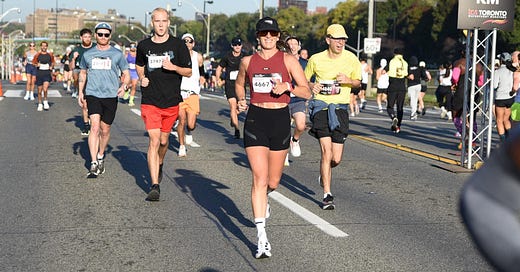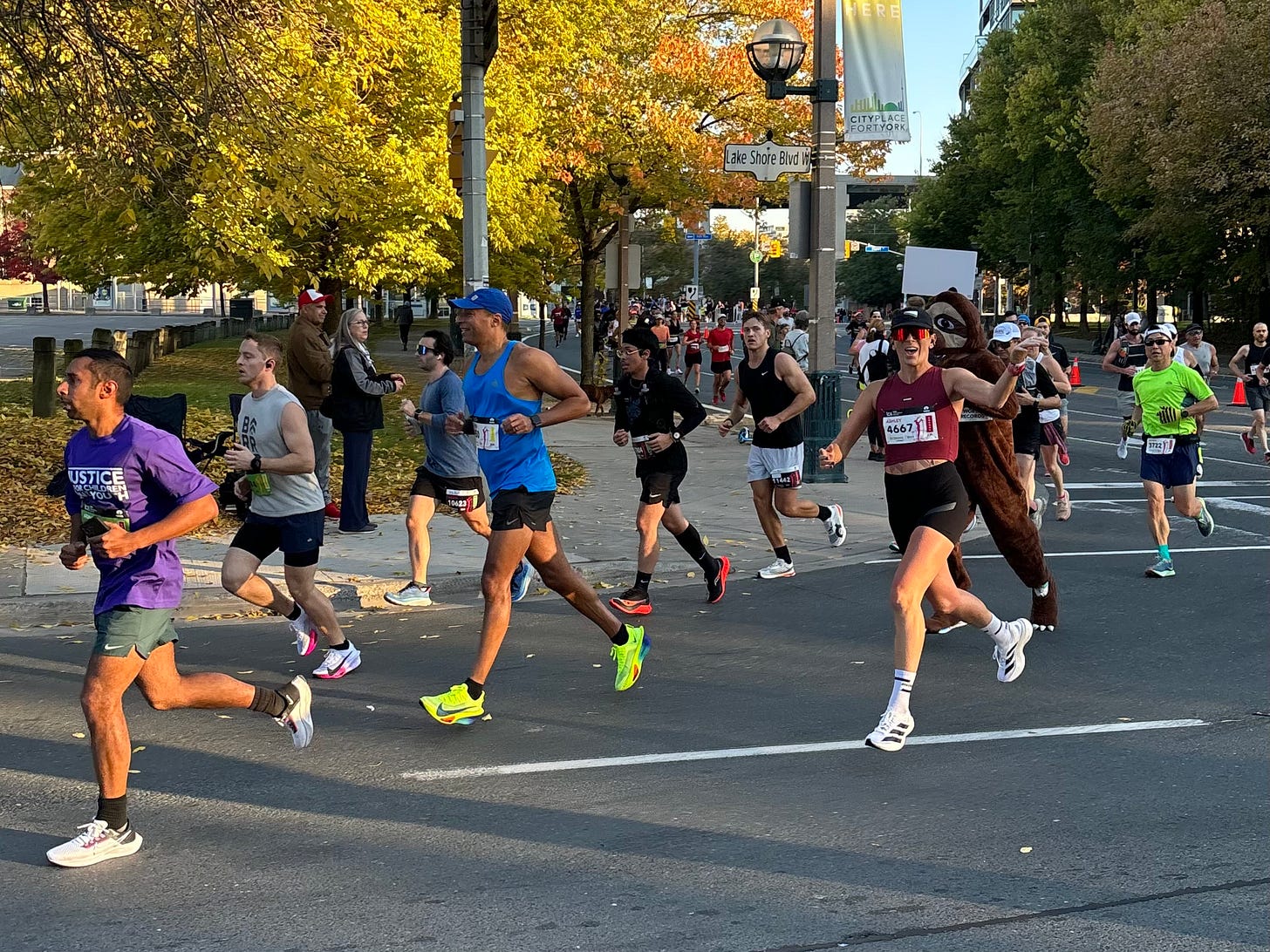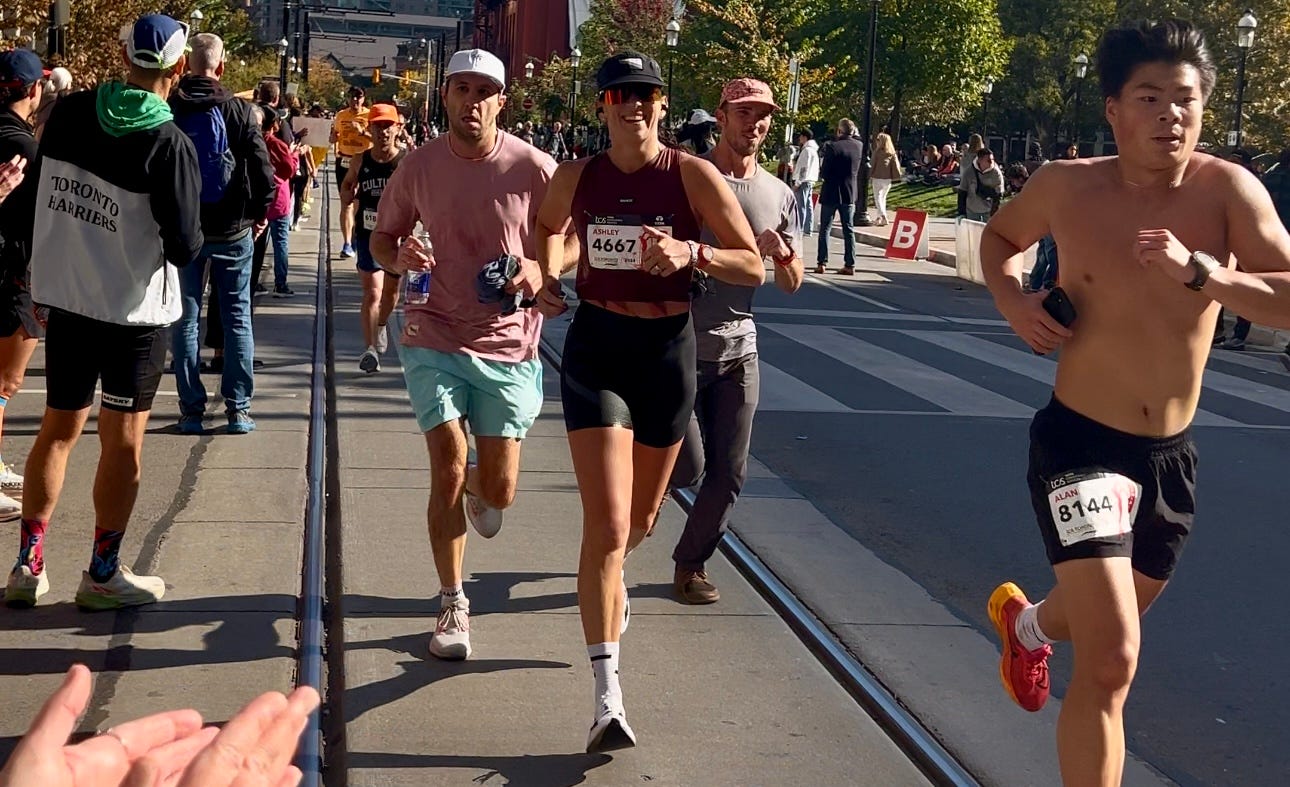This weekend, I snuck up to Canada this weekend to race the Toronto Waterfront Marathon, and ran away with a 3-minute PR from one of the best races I’ve ever executed.
Earlier this year, my Denver run club decided to organize a group race trip and landed on Toronto because the training dates worked with the fall Marathon Majors but didn’t leave registration up to a lottery. Plus, we could choose from the marathon or half marathon distance (I was the only one who ended up running the marathon, go figure). I knew I wanted to race another fall marathon like I did St. George last year—no social media pressure, no juggling work and performance goals—and Toronto, which draws about 12,000 runners for the half and 6,000 runners for the marathon, seemed like a perfect choice.
This course, which starts downtown and mostly runs along the shores of Lake Ontario, is known to be relatively flat and fast, with a total gain of approximately 450 feet. There are a number of out-and-backs on the course, which I loved that about Tokyo, and I thought that would be helpful in case the spectator crowds were thin. And I was hoping the historically good weather would hold out for me (I am so sick of running hot marathons).
We were gifted a beautiful weekend in Toronto. Flying in, we could see the red, orange, and yellow fall foliage dotting the city, and we woke up to a 46°F race morning, with clear skies, just a little bit of wind, and 87 percent humidity (kill me). My only complaint about the race organization was the slightly chaotic bathroom situation near the corrals; people with much later start times were crowded into the port-a-potty lines next to my corral, which started first, and standing in line for 30 minutes didn’t help my heart rate for the start. Otherwise, the start was so smooth it nearly caught me off guard how quickly they shuffled us up to the front.
And then we were off! The first half of this marathon, which is run in tandem with the half marathon, was a 10 out of 10. We started on a gentle uphill for about 2.5 kilometers, which made it easier to keep my pace in check, then looped back through downtown on a nice downhill towards the waterfront. Railroad tracks criss-crossed the streets for most of this section, so I was very wary about where I stepped and glad that the race wasn’t overly crowded. It would have been extremely easy to roll an ankle here. I wish I remembered more details about my surroundings here, but I was pretty locked into my pace and just appreciated how solid the spectator crowds were until around 8K, when we were solidly settled into the big out-and-back on Lakeshore Boulevard.
The turnaround was at 12.5K, and then we stayed on the waterfront until about 19K. That gave me the chance to see the elites (and some of my faster friends) on the road across from us, which was a nice distraction from a lack of anything particularly scenic. We also had some solid ups and downs here; the overpass around 15K was definitely not my favorite. Between 19K and 20K was one of my favorite parts of the course, though; we were running under an underpass, and several run crews used this spot to amplify their cheering and it felt pretty epic to hear their screams bringing the half marathoners towards their final kilometer. (The underpass messed with my GPS pretty significantly in this mile, but I didn’t freak out; I just focused on maintaining the same effort and trusted that it would fix itself.)
Around 20.5K, the marathoners made a turn to the right while the half marathoners continued straight towards the finish line. I thought this might be a tough point mentally, but I watched a friend I had been leapfrogging back and forth with for the first half kick it into high gear and the hopes of her hitting her PR kept me going for the next little bit (she texted to say she did, in fact, PR!). Then the marathoners were in a whole new race. The crowds thinned significantly after 22K, and we had a weird area with lots of turns to navigate between there and 27K. This is where my “effortless” pace started to feel like it was taking some effort. But I was ticking miles off like a metronome. I’ve never in my life run miles this consistent, and I wasn’t even obsessively looking at my watch to do it.
Around 27K, my stomach was feeling a little unsettled; I’m not really sure why, maybe the heat? The temperature wasn’t anything crazy, but we had been totally exposed to the sun basically since 12.5K (minus a K or two under the underpass) and maybe that was catching up to me. I debated whether taking my fourth gel was a good idea or not, and ultimately decided to stick with my fueling plan—bad idea, because I immediately dry heaved and then stopped for a few seconds debating whether I was going to puke on the side of the road. I didn’t, so I just got right back to it—with a nice send-off from a very concerned group of spectators, ha. This was probably when things started to get a little dark for me, mentally. I knew I would see friends around 30K, but the final turnaround wasn’t until 33K and I knew there was a climb going into myself. I kept telling myself you don’t have to do anything but maintain this pace. The climb into the Beaches was extremely unwelcome, although we finally had good crowds again! I knew there would have to be a downhill on the other side, so I let their energy carry me uphill.
The slight downhill here wasn’t enough to give me a big mental boost, though. We were out of town too quickly, and kilometers 35 to 39 put us in no-man’s land again and felt interminable under the sun. I was desperate to see my friends at 39K, and I could feel The Cramp starting to make itself known. By mile 23, it was compromising my breathing to the point that I had to walk to try and massage it out. This was definitely my lowest point; I could feel my goal slipping away and I was so frustrated with my body because I had done everything possible to try and prevent this moment. And then I told myself I didn’t work this hard to give up with less than three miles to go, and if I had to intersperse sprints and walking intervals to get to my friends, I would. So I did. And my friends gave me the physical and emotional boost I needed at 39K, running (and walking) alongside me for those last few kilometers and reminding me how close I really was while ignoring my complaints about how stupid marathoning is. When we made it to the second to last turn and I could see City Hall, my friend told me the finish was just around the next corner—I would see it as soon as I turned—and I have never run so fast in a marathon in my life. I took off like something was chasing me, and crossed the finish line with a three-minute PR.
I’m so proud of how I ran this race. I showed up with a plan, and I executed it almost perfectly—which is really the best you can ask for from the marathon. I’m frustrated by The Cramp, mostly because I still don’t know what exactly is going on. I hesitate to call it an injury, although it’s been a chronic pain since April and it does affect my life outside of running. But I’ve seen physical therapists, massage therapists, and my primary care doctor, and we know it’s a muscular issue probably tied to something in my back (so, no, I don’t just need to eat a banana before I run—and generally I’d recommend not offering unsolicited health tips to other runners via social media when you don’t know the whole picture or have any relevant qualifications, but that’s just me!). So far, the only thing that has helped is several strips of what I call emotional support KT Tape on my abs to cue proper form; placebo or not, it kept the cramp at bay until mile 23, which is 20 miles longer than in my most recent half marathon. Whatever it is, it sucks to have something outside of your control derail your race in a way that makes you feel like it wasn’t truly representative of your current fitness.
That said, this race was always about more than the finish time. It was about giving myself a break from back-to-back marathoning so I could really focus on training smart, getting stronger, and finding the joy in the event again. Over the past few months of training, I found myself enjoying running for myself in a way that I had kind of lost before my last few races. I feel like I’ve finally found a place within the sport where I can focus more on the process than the outcome, and I know I’m a better runner for it. And while “fun” isn’t the word I’d use to describe running a marathon at goal race pace, I enjoyed the challenge. Most importantly, I brought myself back from a dark place in a way I’ve never done before in a race and I finished strong—and that means more than the PR, because that’s something I know I can keep building on for the next race. And I’m already hungry for it.
the rundown
Brooks Glycerin Max
I feel like this is the shoe I’ve been waiting for from Brooks. The Glycerin 21 is…fine, and I expected this to be a natural step up (i.e. max just = more foam), but the $200 Glycerin Max is a whole new ball game. It uses a brand-new midsole foam called DNA Tuned, which is nitrogen-infused with larger cells in the heel and smaller cells in the forefoot. The result: It feels really soft on landing, but there’s still some good pop when you push-off (that’s aided by the dramatic Glideroll tech). With 45 millimeters of foam under the heel, it’s a very thicc boi—but I didn’t feel like I was lugging around extra weight. It felt like just the right mix of cushion and snappiness. I’ve been wearing these consistently now for easy runs, and will start adding them into my long run mix after marathon season.
Strava Is Affecting Your Mental Health
I talk a lot about how social media affects your mental health (it’s why I don’t share my paces on Instagram anymore), and new research is looking at Strava specifically. The Minnesota Star Tribune recently reported on two studies that found that even though Strava users recognize the app’s ability to motivate them into action and connect them to other exercisers, the app’s use brings on anxiety about their performance after the fact. One of the most interesting parts of the article was on how professional or semipro runners use the app—turns out, they’re more likely to hide data they thought was undesirable or add excuses (i.e. running with someone slower) to what they saw as “bad” runs. Remember. A social media profile is a curate snapshot of someone’s training, not something you should ever compare your own running to.
Water Dousing Improves Endurance In the Heat
Oh, good—my strategy actually works! I feel like I’ve dumped more water on my body in my last few marathons than I’ve actually drank, and I do prioritize hydrating. When trained runners poured water over their heads in 10K time trials and 60-minute fixed pace runs in 86°F with 47.4 percent relative humidity, they improved their 10K performance by 27 seconds, according to a September 2024 study in the International Journal of Sports Physiology and Performance. The thermoregulatory benefits included decreased skin temperature, heart rate, thermal sensation, and sweat rate. Even though there were no effects on core temperature or rating of perceived exertion, the researchers concluded dousing is an effective strategy to improve endurance performance in the heat. Bring it on, NYC.
Can We Believe In 2:09:56?
I’ve seen some truly unhinged takes on Ruth Chepngetich’s world record over the past week, and it’s frustrating to see so many people claiming to “know” the truth without any proof. On the flip side, the latest episode of The Real Science of Sport Podcast with sports editor Mike Finch and sports scientist Ross Tucker is a much more measured, nuanced analysis of not just her record-breaking run, but the immediate reaction. It’s a long episode, but they talk about the significance of this record and how it fits into historic running performances, the potential reasons for her performance and the potential reasons behind the controversy around it. It’s a long one, but if you’re interested in a take based more on science than opinion, this is a good one.












Science of Sport podcast always delivers good stuff...except I never listen to the rugby episodes lol.
Way to go in Toronto!
Thank you for an excellent race report! I have been considering this race for next fall and it’s definitely a top contender. I also appreciate your observations on finding races where you can “run your own race” and the mysteries we wrestle with in our attempts to master the marathon. I’ve been at it for 40 years. I’ve had wins and flops. I still struggle with GI issues (and no, please don’t tell me to just train my gut). But you showed how we can succeed even with those hurdles. Brava!